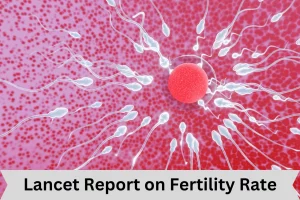ForumIAS announcing GS Foundation Program for UPSC CSE 2025-26 from 19 April. Click Here for more information.
ForumIAS Answer Writing Focus Group (AWFG) for Mains 2024 commencing from 24th June 2024. The Entrance Test for the program will be held on 28th April 2024 at 9 AM. To know more about the program visit: https://forumias.com/blog/awfg2024
Source-This post on Young and the old – lancet report on fertility rate has been created based on the article “Express View on India’s falling fertility rate: A wake-up call” published in “The Indian Express” on 29 March 2024.
UPSC Syllabus-GS Paper 1-Indian society- Population and Associated Issues, Poverty and Developmental issues
Context– According to medical journal Lancet, India’s TFR will fall to 1.29 in 2050. One in five persons in India will be above the age of 60 in 2050.This highlights that India’s demographic dividend is not for perpetuity. Lancet Report on Fertility Rate
What is Total Fertility rate and Replacement level?
TFR– It is the average number of children that are born to a woman (15-49 years) over her lifetime.
Replacement level– It is the level of fertility at which a population exactly replaces itself from one generation to the next. A TFR of 2.1 is known as replacement rate.
What are the key highlights of the lancet study?
1) Decline in TFR– India’s TFR has fallen to 1.29 well below the replacement rate of 2.1.
2) Aging factor– One in five persons in India will be above the age of 60 in 2050. Further as per the UN Population Fund’s (UNPF) India Ageing Report, the number of elderly in India will more than double from 149 million in 2022 to 347 million by mid-century.
3) About China- China’s TFR had dropped to a record low and its working-age population had contracted by more than 40 million.
Read more- various opportunities and challenges of demographic dividend in India
What are the consequences of declining fertility rate?
1) Increase in aged population– By 2050, over 20% of India’s population will be senior citizens, it poses challenges related to care, support, and health care.
2) Shrinking Workforce– A smaller working age population could lead to labour shortages and affect economic growth. For ex- working-age population of China had contracted by more than 40 million.
3) Endanger Demographic Dividend- Experiences of developed nations suggests that once fertility rates fall below the replacement rate, it’s almost impossible to set them back.
India’s TFR is 1.9 which is currently just below the replacement rate.Further,as per UNPF calculations, the share of the country’s working-age population will peak in the late 2030s and early 40s.Thus, in the background of these population trends, it is important to reap Indias full demographic dividend.
What should be the way forward?
1) Skill Development-There is an urgent need to overcome skill deficits and plug gaps in the knowledge economy.
2) Diversifying employment pattern-There should be creation of jobs outside of agriculture.Further,the jobs must not be in the low-paid informal sector.
3) Social security measures– The government should ensure adequate social security and healthcare provisions for the growing elderly population. Along with this, the government should create opportunities for the elderly population to harness their skills effectively.
4) Addressing regional imbalance-TFR rate is not uniform across all Indian states. For ex- parts of south India and west India are greying faster than those in the north. Thus, the policymakers should acknowledge the demographic imbalance in all its dimensions and prepare for the change.
Question for practice
What are the long-term consequences of declining fertility rate? What steps can be taken to overcome the challenge posed by declining fertility rate?





